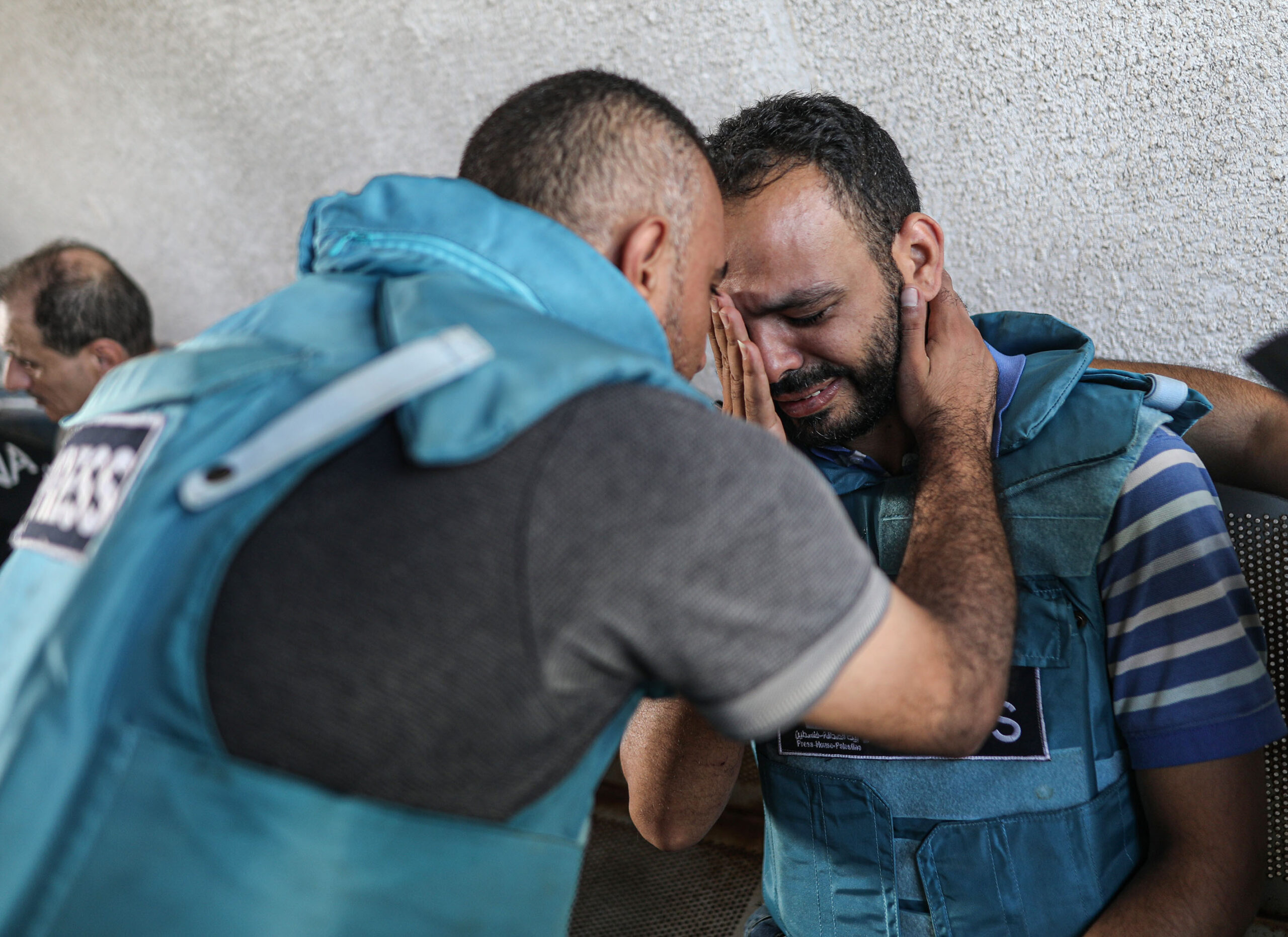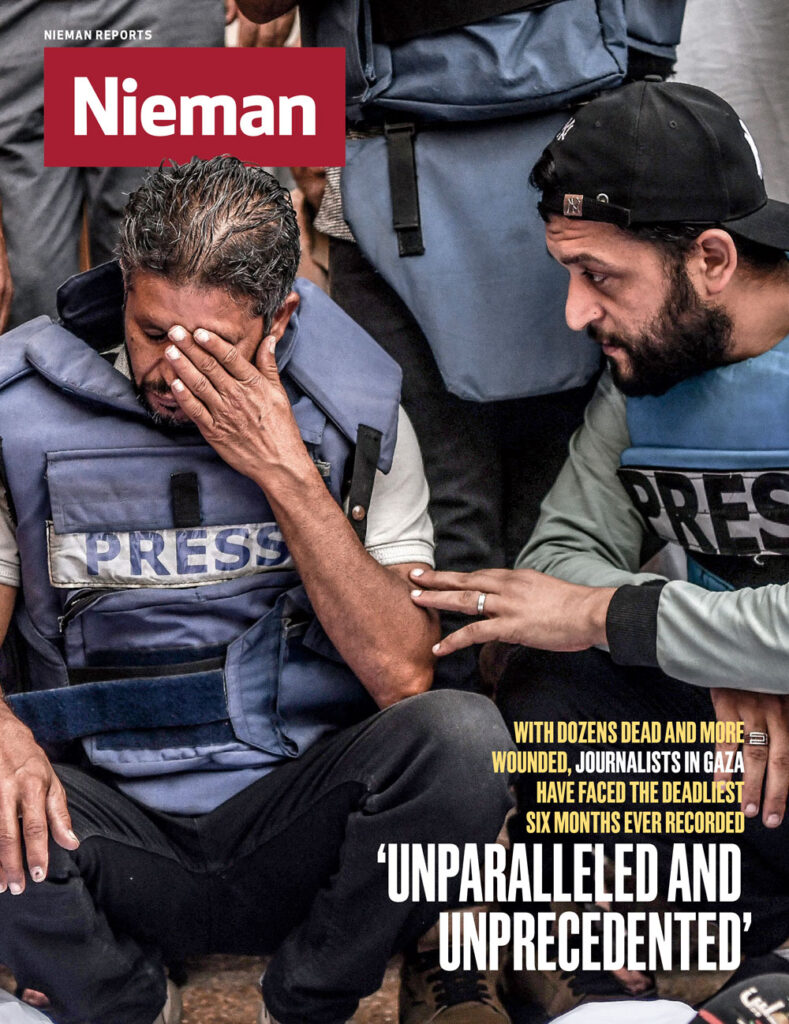
Since Hamas’ deadly Oct. 7 attack on Israeli settlements and a music festival, some 97 journalists and media workers have been killed in the conflict. That is more journalist fatalities in one conflict zone in six months than have occurred in one year worldwide since the Committee to Protect Journalists started keeping the data in 1992.
Nieman Reports’ Winter/Spring 2024 issue spotlights how the war in Gaza is part of an alarming trend of the lack of accountability for killers and jailers of journalists. From the Russian invasion of Ukraine, the rise of authoritarian governments, the miasma of misinformation fostering distrust and suspicion, and the impunity shown by governments, the risk posed to journalists have multiplied in recent years.
Ten years ago, AP photographer Anya Niedringhaus died in Afghanistan, shot dead in her car by a fanatical police officer who also badly wounded her close friend, AP journalist Kathy Gannon. Killings of journalists in Afghanistan, Gaza, and Syria in that crisis year brought deep grief and soul-searching in the journalistic community. The ISIS beheadings of Jim Foley and Steven Sotloff in Syria, especially, widened the public’s awareness of the extreme danger global journalists face daily to bring reliable information to the world. In response, many organizations made improvements in safety protocols, invested in training and protective equipment, and supported the creation of ACOS, A Culture of Safety Alliance, an organization dedicated to supporting freelance and local journalists, especially those covering conflict. As international editor of The Associated Press, I was deeply involved in all these activities.
But in the ensuing decade, the situation for journalists has only worsened. The war in Gaza, the Russian invasion of Ukraine, the rise of authoritarian governments, the miasma of misinformation fostering distrust and suspicion, the impunity shown by governments, and the lack of accountability or shame for killers and jailers of journalists mean that the ground underneath our profession has become even more treacherous.
In Gaza and Israel alone, since Hamas’ deadly Oct. 7 attack on Israeli settlements and a music festival, some 95 journalists and media workers were confirmed dead by late March, among them 90 Palestinians, two Israelis and three Lebanese, according to the Committee to Protect Journalists. That is more journalist fatalities in one conflict zone in six months than have occurred in one year worldwide since CPJ started keeping the data in 1992.
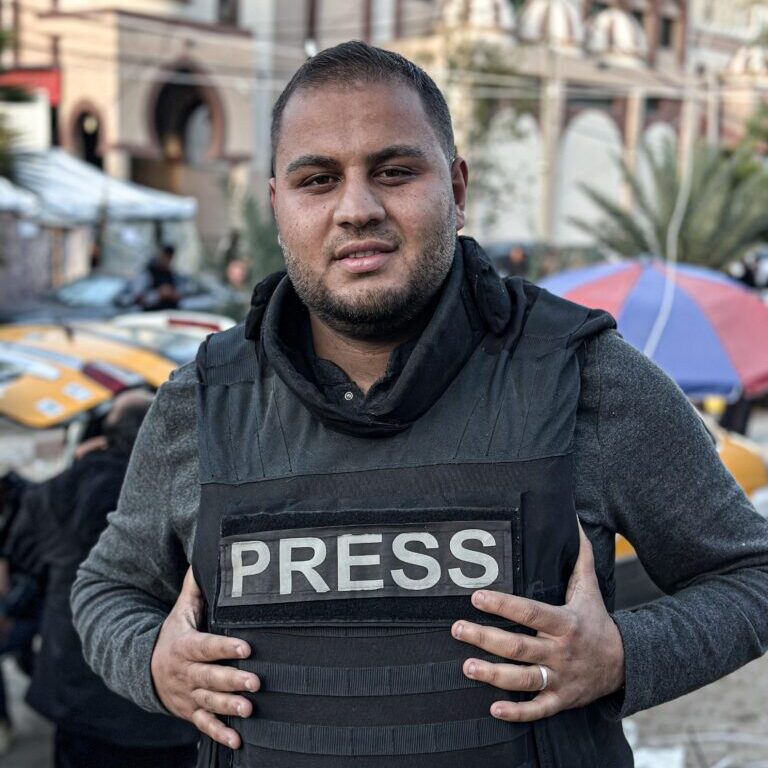
Al Jazeera
Hamza Al Dahdouh, Jan. 7th, 2024
Hamza Al Dahdouh, the eldest son of Al-Jazeera’s Gaza bureau chief, Wael Al Dahdouh, was killed when an Israeli drone struck the car he was traveling in while on assignment in southwest Gaza, according to CPJ. Described as both a journalist and cameraman for the network, the younger Al Dahdouh was reportedly on his way to interview civilians affected by the bombing of a so-called humanitarian zone. Throughout the conflict, Hamza documented the chaotic scenes in hospitals, the injuries sustained by children, the cramped conditions in refugee camps, and makeshift morgues both for Al-Jazeera and his more than one million followers on Instagram. Hamza was the fifth member of his family to die in the conflict.
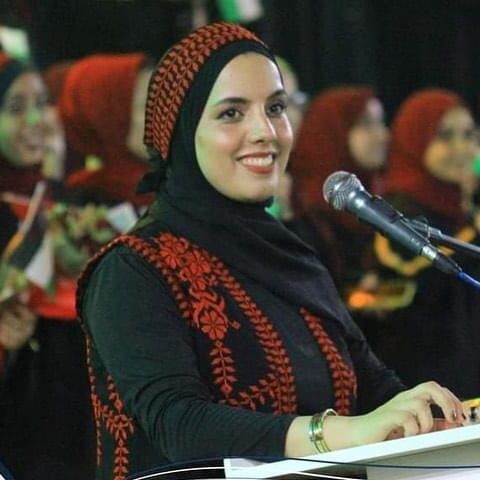
The Khadoura Family
Ayat Khadoura, Nov. 20, 2023
Ayat Khadoura, 27, was a freelance broadcast journalist and online podcaster known for having a beautiful voice and her desire to shed light on the struggles faced by the people of Gaza, according to colleagues. Khadoura, who studied digital media at Al Quds University, was killed in an Israeli air strike on her home in northern Gaza. She had become internationally recognized for her videos showing people mourning loved ones, in need of medical care, and scrambling to find food. “As much as people have filmed and documented what’s happening, there are some things you can’t explain,” she said in an Instagram post shortly before her death. “When the war ends, who’ll be left to tell people what happened to us?”
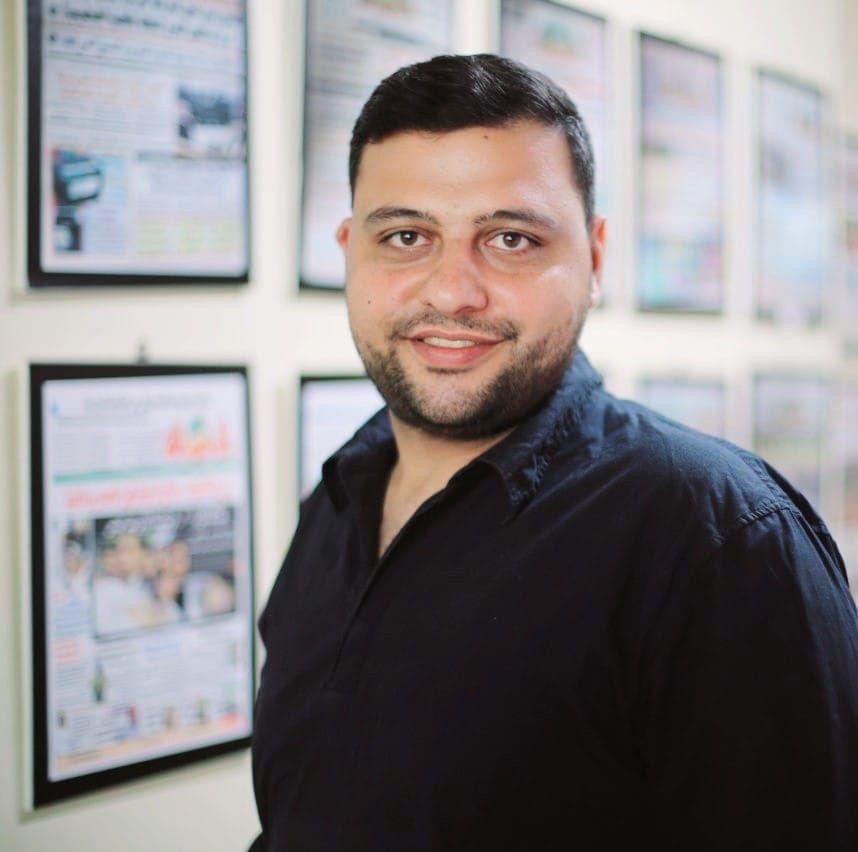
Raseef22
Mohammed Atallah, Jan. 29, 2024
Mohammed Atallah, 24, worked as an editor for Al-Resalah, a local Palestinian news website, and as a freelancer for Raseef22, a regional outlet for which he covered the latest Israeli bombing campaign, the stigma associated with mental health care, and suicides among Palestinians. As a journalist, Atallah was interested in reporting on political affairs, according to his biography on Raseef22. He was killed in an Israeli airstrike on the Beach refugee camp near Gaza City. “Mohammed was a very professional journalist,” Ayman Sharrouf, an editor with Raseef22, told CPJ. “He wanted to relay the voices of the people. He worked hard on his pieces and was very keen on factual reporting of the daily life of Gaza’s people.”
Among the Palestinian journalists who perished in Gaza, there is uncertainty about the numbers killed intentionally for their work reporting on the conflict and how many were victims of the Israeli bombardment of the densely populated 140-square mile strip of land that is home to more than two million people. But in at least a dozen cases, there were indications of the deliberate targeting of journalists, according to CPJ. Among them is Al-Jazeera’s Hamza Al Dahdouh, the 27-year-old son of one of Gaza’s best-known journalists, Al-Jazeera bureau chief Wael Al Dahdouh, who had already lost four family members in Israeli attacks. The car that the younger Al Dahdouh was traveling in was struck by an Israeli drone Jan. 7 returning from an assignment near Rafah, killing him and another Palestinian colleague, Mustafa Thuraya. Israel said that they were suspected of being terrorists and noted that a journalist team with them had flown a drone over the site of a prior Israeli attack. The families of Al Dahdouh and Thuraya vehemently denied the terrorism accusation.
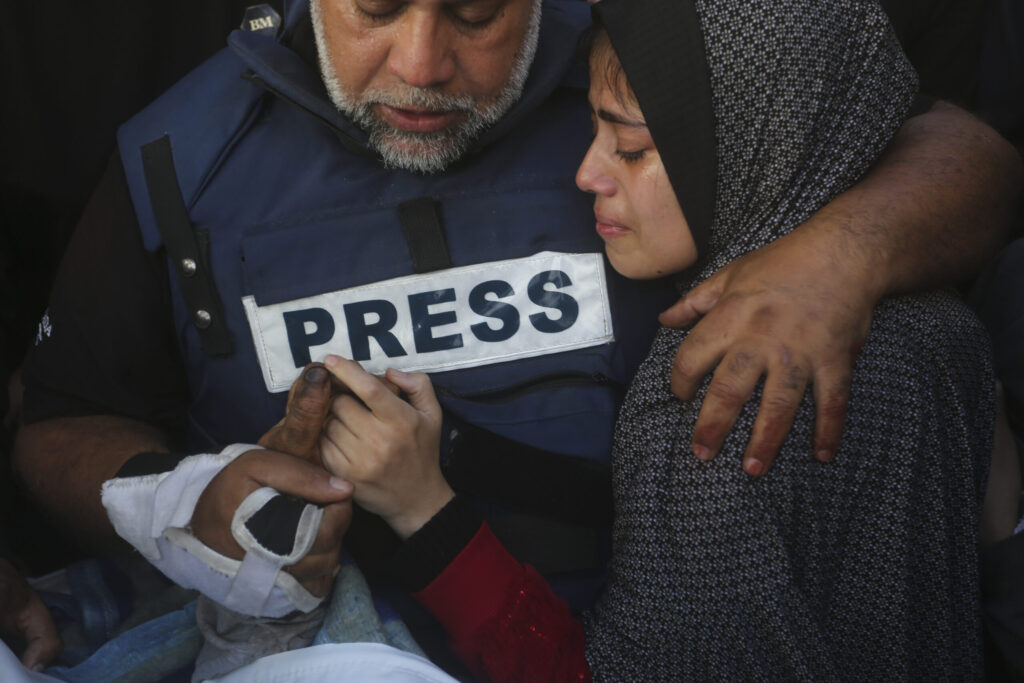
“What we saw is unparalleled and unprecedented and of course that means it has far-reaching consequences,” said Sherif Mansour, CPJ's Middle East and North Africa program coordinator, noting that the suppression of reporting means less credible information for the rest of the world, especially given that most international journalists have been denied access to Gaza. “In many ways, this has been the most dangerous assignment or environment that we have seen for journalists.”
“When journalists are killed, we lose the ability to understand and to document the war,” he added. “We need journalists to understand the motivations of the warring parties and the implications of their policies. If we don’t have journalists, we lose a window to what is happening.”
The deaths among journalists come as the number of total deaths in Gaza have risen to more than 31,000, according to health authorities in the Hamas-controlled territory, as Israeli air and ground forces have sought to destroy Hamas and its fighters and eliminate any future threats to Israel. Like the general population, journalists have been forced to evacuate Gaza City in the north for southern Gazan cities like Khan Younis and Rafah. There they find shelter with relatives or wherever they can, struggling for food, water, and fuel to live while documenting the attacks. Even so-called safe areas have increasingly been struck. With death random, many continue to work out of both a sense of duty and a fatalism that nowhere is safe.
This loss of lives occurs in a region where reporting has long been under serious threat. CPJ’s accounting of journalists killed since Oct. 7 includes reporters who are freelance or employed by Palestinian news outlets, some affiliated with the Hamas government, or for an array of Arab and Middle Eastern television stations or news agencies. A few have been employed by Western agencies, such as Reuters video journalist Isaam Abdallah, who died Oct. 13 when, according to CPJ, two Israeli tank shells fired at his position in southern Lebanon even though he and other journalists around him were wearing press insignia and standing near a car labeled “TV” while documenting back and forth fire. Six other journalists were injured in the incident.
Historically, labeling oneself as press and keeping cameras and equipment visible during combat has offered some measure of protection for journalists. But the soldiers firing on these journalists either did not believe the insignia, or did not care. Or there could be a darker agenda: censorship — to deny the world their reporting, especially at a time when international correspondents are being denied access.
“When journalists are killed, we lose the ability to understand and to document the war. We need journalists to understand the motivations of the warring parties and the implications of their policies. If we don’t have journalists, we lose a window to what is happening.”
— Sherif Mansour, CPJ’s Middle East and North Africa program coordinator
Prior to the present fighting, CPJ documented in a May report that Israel Defense Forces had killed at least 20 journalists over the past 22 years, and not one IDF soldier was punished or held accountable. The report, titled “Deadly Pattern,” concluded that the Israeli government evaded responsibility for the deaths by dragging out investigations, accusing the journalists of being terrorists, keeping the evidence classified, and saying their troops feared for their lives. In one high-profile case, Shireen Abu Akleh, a 51-year-old Palestinian-American correspondent for Al-Jazeera, was killed while covering an Israeli raid in the city of Jenin in the West Bank. Investigations by several news organizations, including The Associated Press, concluded that she was not near active fighting when she was shot while wearing a vest that clearly marked her as a journalist. Israel has said the bullet that killed her was likely fired by an Israeli soldier, but it blamed crossfire with Palestinian militants — a claim contradicted by videos taken that day.
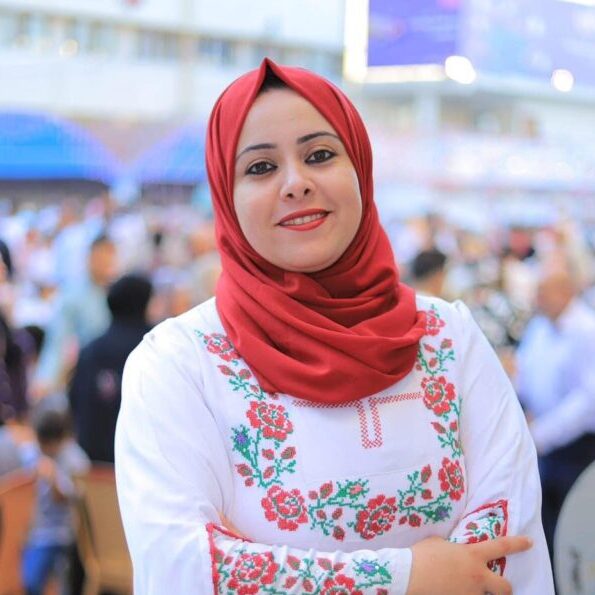
The Al-Abadla Family
Heba Al-Abadla, Jan. 9, 2024
Al-Abadla, her mother, and her daughter, were killed when an Israeli airstrike hit her house in Khan Younis, according to the Palestinian Journalists Syndicate. The 30-year-old contributed as an anchor to local radio networks, including Al-Azhar Radio, that is affiliated with Al-Azhar University, which focuses on campus news. She also worked with Internews, an independent publication that covers the West Bank and Gaza. Al-Abadla was a founder and board member of Social Media Club Palestine, which memorialized her on Facebook. “She was a real example of what hard work looks like,” the club wrote. “She was a determined, active soul, who left a legacy behind that we’ll never forget.”
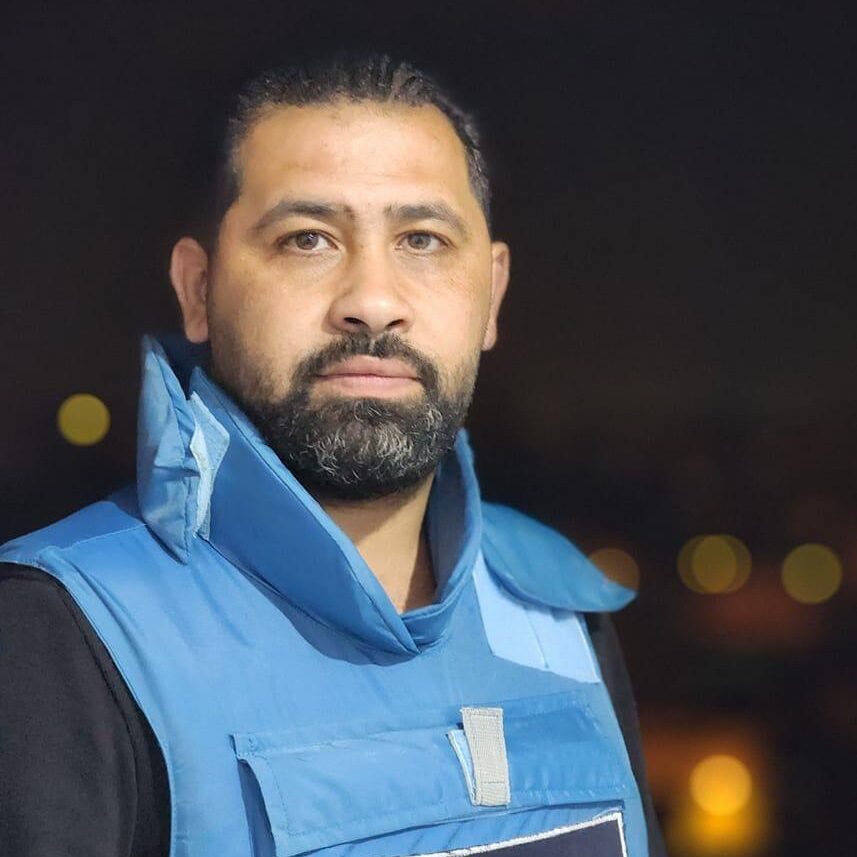
The al-Taweel Family
Saeed al-Taweel, Oct. 10, 2023
Al-Taweel was the editor-in-chief of Al-Khamsa News, an independent television station and website that covers everything from the conflict in Gaza to technology and sports. He died after Israeli airstrikes hit an area in Gaza City where several media outlets were located, according to the Committee to Protect Journalists. Al-Jazeera reported that al-Taweel was out in the field filming a building expected to be a target when he was killed. Known as a “kind-hearted” and “generous” editor among his colleagues, al-Taweel held a master’s degree in journalism and mass communication from the Islamic University of Gaza. He was also a media lecturer and was described as a leader within the Gazan media.
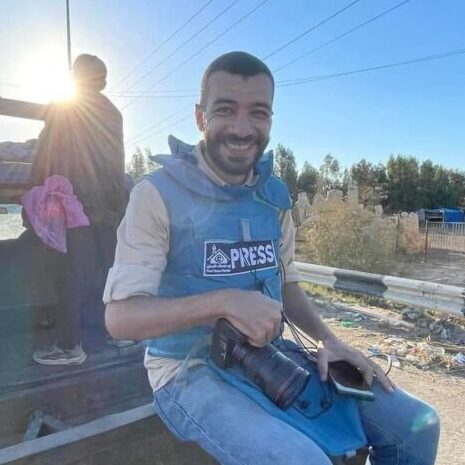
Mohamed Yaghi, Feb. 23, 2024
Yaghi was a freelance photojournalist who worked with Al-Jazeera and several other international news organizations. His father, Teshreen, said that Mohamed wanted to be a journalist since he was a young boy and loved his work, having pursued a university degree in media, according to Al-Jazeera. At the time of his death, Yaghi was working on a documentary about civil defense servicemen in Gaza. He was killed in an Israeli airstrike in Az-Zawayda, a town in central Gaza, along with his wife, young daughter and more than 30 other family members, according to the Committee to Protect Journalists. In an article marking his death, Al-Jazeera noted that Yaghi was highly skilled in video editing.
Ola Atallah, Dec. 9, 2023
Atallah, 43, was an independent Palestinian journalist who reported for multiple news organizations including the Anadolu Agency, a Turkish news outlet. She began covering conflict between Gaza and Israel in 2008, wrote about the conflict in Syria, and reported on the plight of Gazan fishermen. An award-winning journalist, Atallah graduated with distinction from the Islamic University of Gaza in 2002 with a degree in journalism and media. She was killed with nine other members of her family in an Israeli airstrike in Gaza City, according to CPJ. Her last personal essay was published in November, titled “A Message from Gaza, a Different City,” in which she wrote “this war’s horrors cannot be described in all the languages of the universe.”
Yazan al-Zuweidi, Jan. 14, 2024
Al-Zuweidi worked as a photojournalist for Al-Ghad TV channel, a broadcaster launched in Cairo. He worked there for six years covering wars and conflicts in Gaza over that period of time. Ahmed Ouda, head of Al-Ghad TV’s Gaza office, described Yazan as a “polite, generous, energetic man who was eager to work hard and learn.” Al-Zuweidi, who was 27 when he died, “would be prepared to film live videos from the roof of the Al-Ghad Office building in Gaza, and would be bold enough to livestream events that showed Palestinians who were killed and wounded on the sites of conflict,” Ouda added. Al-Zuweidi died in an airstrike in northern Gaza, according to CPJ.
In early April, Israeli Prime Minister Benjamin Netanyahu vowed to expel Qatari-owned Al Jazeera from operating inside Israel, accusing it of being a “terror network” and actively participating in the Oct. 7 attack. The move came after parliament passed legislation allowing the prime minister to shut down any foreign-owned news organization deemed a security threat. The network called the accusation a “dangerous lie” intended to further suppress independent reporting of the conflict, and one that could lead to greater risk for its journalists. Qatar is among the few Arab countries that has acted as a mediator with Hamas.
With this astounding loss of life, and the continued verbal, physical, and legislative attacks on independent journalism itself around the world from sources as diverse as Vladimir Putin, supporters of the MAGA movement in the United States, and Mexican criminal gangs, journalists and those who care about truthful factual reporting are left to wonder again: What can be done?
Putin’s cynical hostage-taking in the case of Wall Street Journal reporter Evan Gershkovich, falsely accused of espionage and imprisoned in Russia for a year as a bargaining chip with the West, shows the utter contempt with which some journalists are being treated.
It is clear the old slogans of “End Impunity” and “Journalism is not a crime” are inadequate to the moment.
While there was never a time of perfect security, the historic calculus between journalists and combatants has changed in dangerous ways. The ease with which even terrorists can communicate directly with the public has made reporters expendable or even targets themselves because their reporting has the power to shift public opinion or embarrass regimes. Longtime international correspondent Richard Boudreaux, now a standards editor at The Wall Street Journal in London, notes that this change is a dramatic generational shift.
“When I was in Latin America in the 80s and early 90s, the guerrillas and the death squads both wanted to woo the press. We were sought after; nobody was going to mess with us,” he recalled. But now, he said, “We found as we got into this new century … they don’t need an intermediary.”
Two trends are working to undermine the safety of journalists. The first is the rise and ubiquity of social media, which in turn has led to the rapid spread of mis- and disinformation and a generalized decline in the respect for the role of a journalist as an arbiter of facts. The second is the market pressures on news organizations, which leaves them with fewer resources to defend and protect journalists in the field.
“Social media complicates safety, online harassment intimidates journalists, and it can get amplified thousands of times and can lead to real online and offline threats,” said Mark Grant, AP’s vice president for global security and safety.
In Ukraine, he said, the new technology of war makes it more dangerous for journalists in the field. Reporters are visible because of drones, which means it’s harder to operate independently and many embed with armed forces. That is both dangerous, in case of combat and attacks, and it results in a more limited, one-sided view of the conflict.
“Freelancers especially are at risk because they do not have a large news organization watching out for them, assessing risk, providing PPE and medical care and training,” Grant said.
In response, newsrooms are responding by using GPS and other technologies to track journalists in the field and lock down or wipe devices remotely when necessary to keep sensitive information from falling into the wrong hands. “Just as the people who are trying to prevent journalism get more sophisticated, we have to do the same,” says Kerry Paterson, the U.S. director of safety at AP, noting that journalists are being deployed with more advanced lifesaving medical supplies as well.
Frane Maroevic, executive director of the International Press Institute, the press freedom advocacy organization based in Vienna, said that it is sadly indicative that measures used in the past to protect journalists have become a threat in themselves.
“The symbol of the press that journalists put on their cars, the blue vests, the blue helmets that they wear ... these are no longer symbols for protection,” he said. “They seem to be quite often the target because of that.”
On Feb. 13, days after we spoke, two Al-Jazeera journalists wearing vests clearly marked “Press” were struck by a drone fired at their motorcycle near the city of Rafah, maiming one and severely injuring the other. Al-Jazeera said it believed the reporters were deliberately targeted. Israel later justified the attack, saying the critically injured Ismael Abu Omar was a Hamas deputy commander who had been present at one of the massacre sites of Israelis Oct. 7.
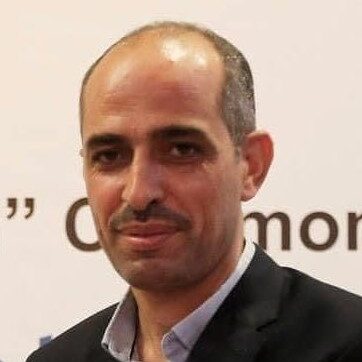
The Jadallah Family
Belal Jadallah, Nov. 19, 2023
Jadallah, founder and general director of Press House-Palestine, a non-profit that supports independent Palestinian media, was killed by an Israeli strike as he was evacuating Gaza City. Known as a father figure for local journalists, he helped train scores of reporters, hosted safety workshops, and distributed helmets and flak jackets. Jadallah also co-founded Sawa News Agency, an independent news outlet based in Gaza, and made Press House a place where weary journalists covering conflict could find relative safety and comfort. After the news of his death broke, tributes to his legacy began pouring in. “Belal was very determined to stay in Gaza City for over a month and strongly believed it was his moral duty to tell the world what he witnesse[d] in the besieged small city, assisting the needy people around him,” his brother, Ali, posted on social media.
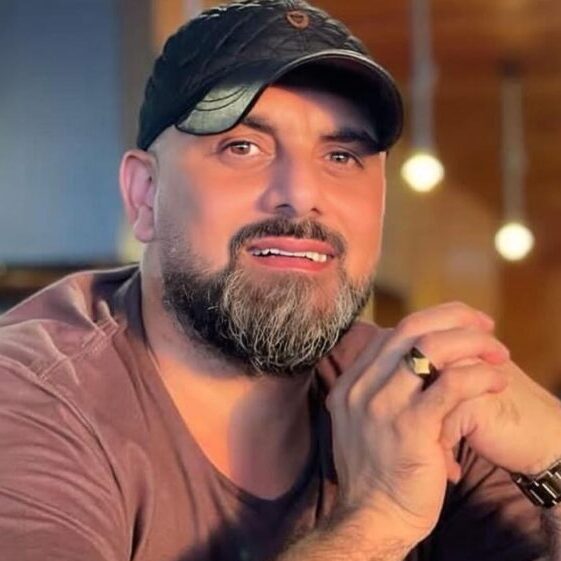
Al Jazeera
Samer Abu Daqqa, Dec. 15, 2023
A cameraman for Al-Jazeera, Samer Abu Daqqa was killed in Khan Younis in southern Gaza, while covering Israeli strikes on a school being used as an emergency shelter. The father of four, who worked for the station for about two decades, was remembered by colleagues for his commitment to covering dangerous stories and his catchphrase “Ready!,” according to Al-Jazeera. “He was, as we say, a journalist’s journalist, somebody who loves to shoot and film and then would come back and tell you the best pictures that he captured,” Ayman Mohyeldin, a former coworker, told NPR. “He was a very funny, very witty but also a very serious cameraman who took his job with a tremendous amount of professionalism.”
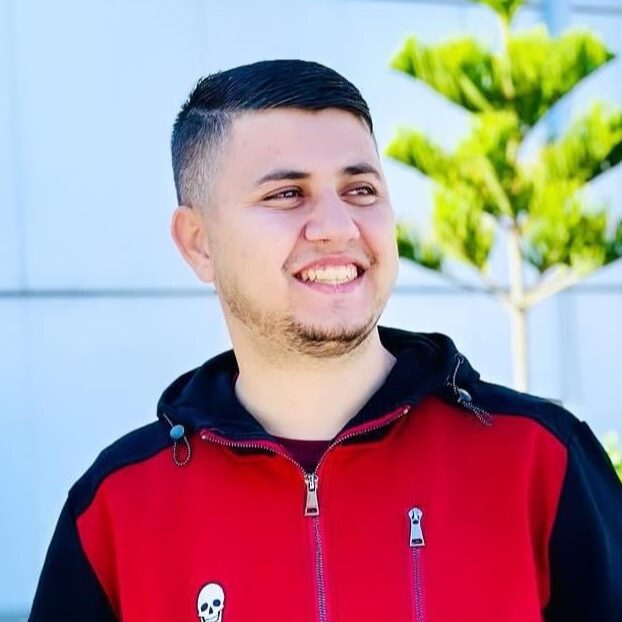
The Thuraya Family
Mustafa Thuraya, Jan. 7, 2024
Thuraya was killed in an Israeli airstrike while reporting on the conditions in southern Gaza as the bombings stretched into 2024. He was on assignment in Nasr village getting video of the scene as emergency personnel were clearing human remains from the site, the Committee to Protect Journalists said. He died just a few minutes after two other journalists working nearby were injured. A well-known drone operator and freelance videographer, Thuraya studied media at Al-Azhar University, according to the Palestinian Journalists Syndicate. The 29-year-old worked for Agence France-Presse and other news outlets, covering life in Gaza and more recently the destruction of the latest conflict.
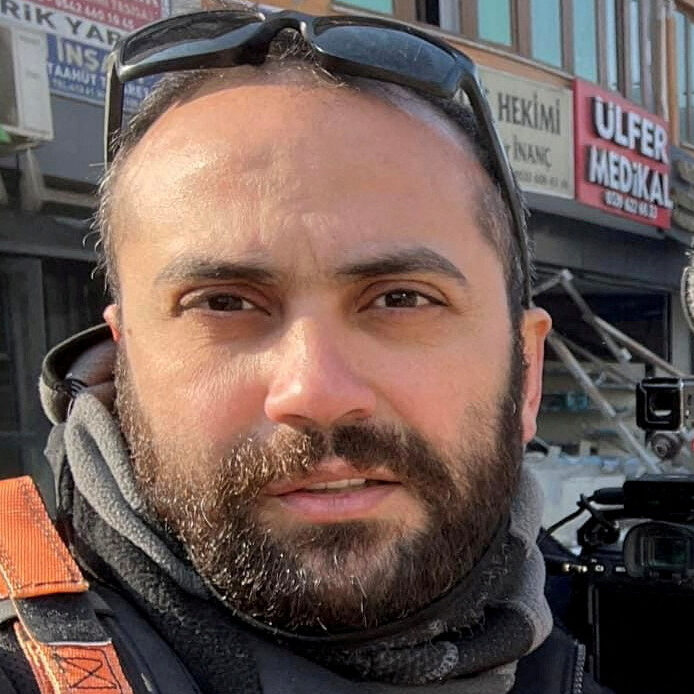
Reuters
Issam Abdallah, Oct. 13, 2023
Issam Abdallah, a 37-year-old visuals journalist for Reuters who reported from several conflict zones, including Ukraine, Iraq, and Syria, was killed in Lebanon while covering fighting between the Israeli military and Iran-back Hezbollah militants. A native of Lebanon, Abdallah worked out of the Reuter’s Beirut bureau and began working for the company as a freelancer 16 years ago while he was still in university. “I have learned through all the years of covering conflicts and wars with Reuters from around the region that the picture is not only front lines and smoke, but the untold human stories which touch us all inside,” he wrote, according to his obituary, after being on assignment in Ukraine.

Shai Mahloof, Ynet
Roee Idan, declared dead on Oct. 20, 2023
Roee Idan, a photographer for Ynet, a prominent Israeli news site, was killed after Hamas attacked his home in Kfar Aza on Oct. 7. He was missing for 10 days before his body was found. Before his death, Idan photographed the initial moments of the attack, capturing images of militants paragliding into the area and Israeli defenses intercepting rockets fired from Gaza, according to the Committee to Protect Journalists. The 43-year-old covered a variety of issues including local schools, rocket attacks, and Covid-19 but was said to be drawn to nature photography. His wife was also killed, though his three children — one was abducted but returned — survived the attack.
Maroevic also warns that in addition to the two major conflicts now — Gaza and Ukraine — non-state actors elsewhere are becoming extremely aggressive against journalists and their reporting. “Journalists are being threatened, and also killed, at an alarming rate, which is also a huge threat that we did not see before,” he said. In Mexico, 153 journalists have been killed — many by criminal gangs — since 1992, making it one of the deadliest countries for journalism. (Only a handful of the perpetrators have been brought to justice.) In Sudan, since armed conflict broke out last year between armed factions, journalists have been shot, beaten, and harassed, according to CPJ.
Elisabet Cantenys, the Spain-based director of ACOS, the safety alliance, said safety for journalists is no longer clear-cut or confined to conflict.
“The use of spyware, online harassment and abuse targeting journalists has grown dramatically in frequency and intensity; misinformation and disinformation campaigns have become commonplace, and the use of lawfare and systematic legal and judicial harassment by governments, politicians and individuals is widespread,” she said in an email.
Since it began operating in 2015 in the aftermath of the 2014 killings, ACOS — which was supported in the United States by the Overseas Press Club Foundation — has grown steadily and sought to fill a void in first-aid training and other support for local and freelance journalists. That can include help in obtaining body armor, insurance, and situational safety advice. ACOS also holds workshops for editors to help them with risk assessments and understand the latest tools to keep journalists safe.
This work occurs against a backdrop of a financially weakened media industry. Reporters for big organizations are usually well-equipped, but not so the freelancers and local journalists on which the big organizations increasingly rely. In places like Gaza and Ukraine, there is an abysmal shortage of protective equipment like body armor available to local reporters and freelancers.
The phenomenon of journalists being attacked through government-instigated or partisan disinformation campaigns also is growing.
“The disinformation that somehow journalists were informed of or knew about the attacks in Gaza and were somehow involved in terrorism by itself is not a new trend, but the fact that this trend is being used as a threat on journalists’ safety is,” said Maroevic.
“Governments can foment a Twitter army against you,” said Boudreaux, and then take repressive actions in response.
“The disinformation that somehow journalists were informed of or knew about the attacks in Gaza and were somehow involved in terrorism by itself is not a new trend, but the fact that this trend is being used as a threat on journalists’ safety is.”
— Frane Maroevic, executive director of the International Press Institute
Among the other assorted dangers cited by Cantenys are cross-border killings of journalists, spyware such as the Pegasus program that track journalists’ movements, and lawsuits intended to financially bleed news organizations.
Running through today’s conversations about the safety of journalists is a sense that, in the words of AP’s Paterson, “the space that was held for journalists has been damaged. It is no longer is as protective as it once was.”
Paterson recently joined AP after more than a decade at CPJ.
“To say that a journalist on the battlefield is a civilian, or that a journalist in this space should be allowed to do their job, there has been a real shift in that,” she said. “What you see is that when you chip away at the role that the Fourth Estate plays, when you start to undermine the idea of why a free press is important, you actually quite literally put people in greater risk of harm.”
Of the many challenges facing newsgathering, one of the greatest, says Maroevic, is restoring respect for journalism.
“How can we define the role of journalism so that society also once again becomes, let’s say, a protective shield for journalists so that there is an understanding and respect for the role,” he said. “It’s not a magic solution, but it is I think important.”
Fatma Khaled, a freelancer based in Cairo, contributed research to the writeups of the fallen journalists.
